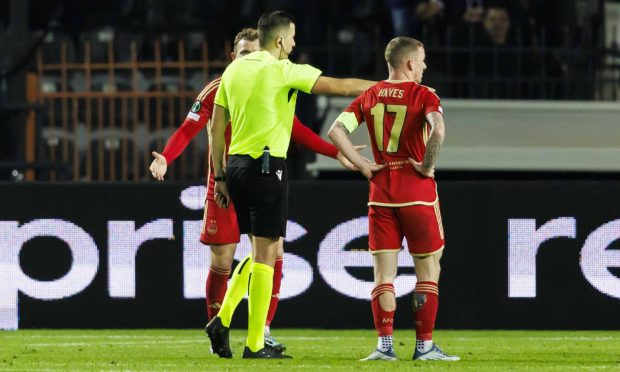Aberdeen travelled to Greece looking to keep their chances of qualifying from the group stage alive as they faced PAOK.
The Dons would put in a valiant effort in the 2-2 draw which would unfortunately leave them eliminated with two games left to play.
The referee was Juxhin Xhaja from Albania, being supported by Italian VAR Daniele Chiffi. How did the referee team get on in Thessaloniki?
There were several talking points throughout the game where I thought the referee should have been stronger. The most obvious ones were two clear and blatant dives in the penalty area from PAOK players.
The first one came from Giannis Konstantelias, who went down under a challenge from Stefan Gartenmann. It was the most obvious dive I have ever seen.
He stays up to try to get the ball, but as soon as he realises it’s going out, he throws himself to the ground.
VAR astonishingly actually checked for a penalty. It was a blatant dive and with the referee awarding a goal kick, I was amazed he didn’t give a free kick and caution to the PAOK player.
The second dive of the game was even worse.
This time the referee was successfully conned by Konstantinos Koulierakis.
From my angle in the stadium Jamie McGrath had blocked the point of contact so it was hard to tell if he was fouled.
I initially thought the PAOK player was potentially offside, I was unaware of just how bad a dive it was.
The referee was sent to the monitor after several minutes to review the challenge, eventually changing his decision. There was 100% no contact and it was a blatant dive.
Now the big question, why didn’t the referee caution the player? VAR cannot give yellow cards, but it can lead to them. This is the perfect example of this.
VAR can’t advise a referee to caution a player, but if he has cheated to get a decision and the referee decides after a review that it was a dive. The referee is well within his right to caution the player.
I was genuinely surprised that he got away without a booking after watching the game back, the referee should have taken a stance with the first dive.
There were definitely some baffling decisions throughout the match, I thought the referee was poor. On more than one occasion he didn’t seem to have control of the game.
Finlay Elder was a registered referee for six years and a category 5 official from 2019, with experience in the Highland League, Juniors and Club Academy.

